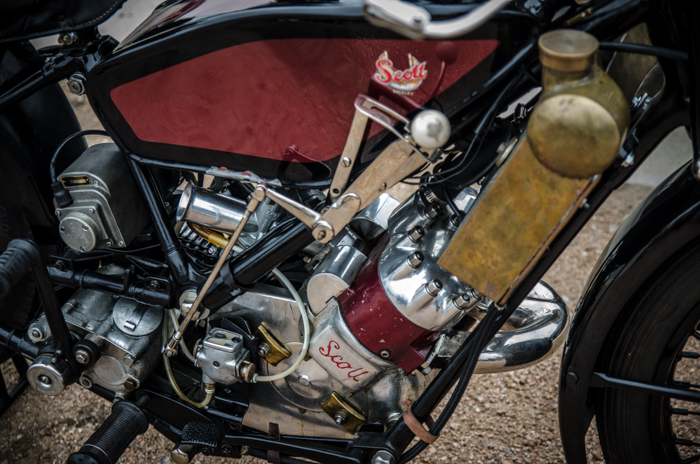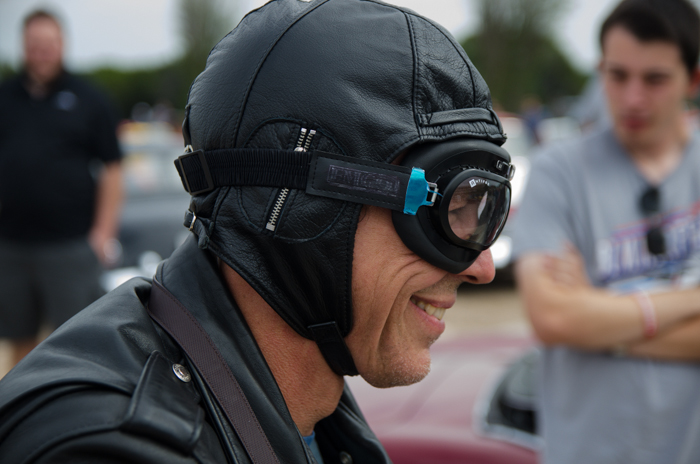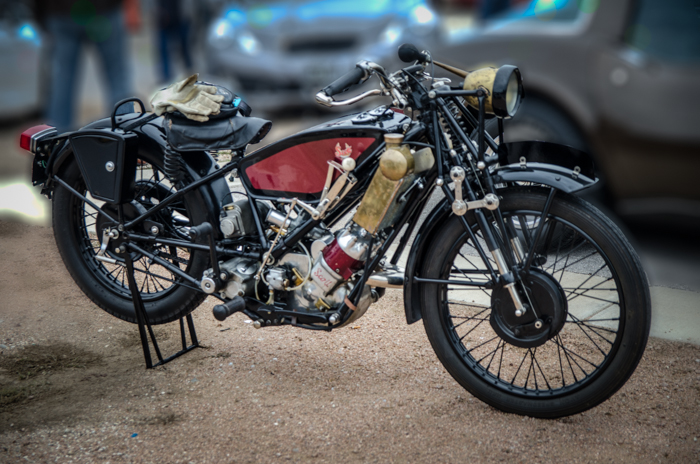
It is not an ordinary sight to see a guy regularly riding a 1927 motorcycle. But then, Mark Scott is not your ordinary motorcyclist!
Yes, Mark, a resident of Volente, Texas, regularly rides his 1927 Scott “Flying Squirrel” motorcycle. Mark acquired his Scott bike, a British marque, in 2001, and has subsequently restored it to beautiful condition.
Mark is certainly not a one-bike guy.
At last count, he owns some 18-20 motorcycles, spanning the gamut between the Flying Squirrel and a modern Kawasaki turbo’d bike. In between there is a 1948 Vincent Rapide, a ’50’s vintage BSA TT bike, Indian Scout, Harley Davidson sprint, and several BMW “airhead” bikes.
The Scott, however, is clearly the crown jewel in this bike lover’s collection. Considering its vintage, the Scott was quite technologically advanced. The 500cc 2-cycle, twin cylinder, water cooled engine was quite innovative, and sported a beautiful British crafted brass radiator that provided passive convective cooling for the engine. The “fuel” tank is divided into two separate compartments, one for gasoline (petrol for you Brits), and the other for the castrol “bean” oil necessary for operation of the 2 cycle engine. This in itself was novel, as most 2 cycle engines of this vintage required the operator to premix the oil and fuel mixture together (somewhat like a weed-eater!).
The internal engine design is also unique in that the flywheel is located in the center of the crankshaft, flanked by a pair of main bearings. The crank is then cantilevered out from that center bearing point, with the rod throws being unsupported at each outer end. A round crank access opening is provided on each side of the case, sealed by beautifully polished aluminum covers which are secured by massive brass dogs.
According to Mark, these covers also serve as safety blowout plugs in case of a backfire into the fuel-mixture filled crankcase.
Mark replaced the original 18 HP engine in his Scott with a similar, but race-modified engine that he estimates generates around 30 HP, enough to push the little bike along at freeway cruising speeds, if you dare. Brakes (drum, front and rear) are small and somewhat marginal at bringing the bike to a halt from those higher speeds, so rider discretion is advised.
The Scott also boasted the first patent for a recoil kick starter, and was kitted with control layout that would be familiar to a current-day motorcyclist.. clutch on left handlebar, front brake on right, and rear brake pedal below the right side foot pedal. The only exception to modern convention is the gear shift mechanism for the 3 speed transmission, which was actuated by a lever on the right side alongside the tank (as was the custom on many bikes of this period).
From stem to stern, this bike just shouts old-world British craftsmanship. Polished aluminum and brass, combined with leather seating, create a true mechanical work of art that would enhance any garage. In fact, this bike is considered so significant that one is included in Jay Leno’s collection.
The Flying Squirrel was envisioned primarily as a racing bike, and as such provided NO instruments of any kind, not even a speedometer. The makers were kind enough to provide a rudimentary headlamp and tail lamp, powered by a tooth-belt-driven magneto.
The innovations on this bike served it well, and brought its team victory in the 1929 Isle of Man.
Sadly, the “state-of-the-art” innovations on the bike were expensive to manufacture, to the extent that sales price of these bikes new was almost double that of competitive 4-cycle engined bikes of the era. As a result, sales were lackluster, and in the wake of the death of the company founder Alfred Scott, the company’s financial situation became more and more dire. Finally, with the outbreak of WWII, production ended, and the original Scott company ceased to exist.
Fortunately, there are aficionados such as Mark Scott (the similar name is only coincidental) who are keeping the brand name alive by sharing these precious bikes with the public!
Central Texas fans of vintage motorcycles will want to be sure and add the Luckenbach Harvest Classic vintage bike show to their calendar (held in late October annually).









Leave a reply